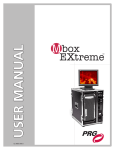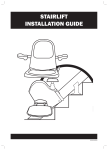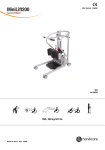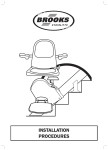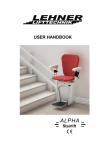Download Brooks Stairlift User manual
Transcript
MANUFACTURER INFORMATION: Name: Address: ACORN Inc. 6450 Kingspointe Parkway, Unit 1, Orlando, Florida, 32819 Helpline: 407 – 650 - 0216 IMPORTANT! READ THESE PROCEDURES THOROUGHLY PRIOR TO stair lift INSTALLATION This information is meant for ACORN authorised engineers in order to ensure servicing of the stair lift in a correct manner. Authorised engineers are persons trained by ACORN and who are sufficient in practical and technical knowledge to safely install the stair lift. HEALTH AND SAFETY HAZARDS The following health and safety hazards should be considered when servicing the stair lift: • • • • • • • • • • The risk of loose clothing or body parts getting trapped Injury resulting from drilling, inappropriate use of tools etc. Direct or indirect electrical contact Falling down the stairs Never use worn tools Correct manual handling procedure (refer to ACORN “Manual Handling” document) Falling tools Tripping hazards on the stairway Use of necessary protection (safety glasses etc) Follow the current regulations regarding safe working practices Prior to carrying out any electrical testing, be aware of the considerations detailed in Appendix I. 1. INSTALLATION 1.1 Installation tools Drill (hammer action) 3mm HSS drill bit 7mm masonry bit Nº2 / Nº3 Philips screwdriver Flat electrical / terminal screwdriver 13mm open / ring spanner 17mm open / ring spanner Socket ratchet Socket extension 13mm socket 1.2 multimeter AC / DC / Ohms Torch / hand lamp Tape measure Side cutters Wire cutters Installation procedure 1.2.1 Preparation on site It is recommended that the following examinations be carried out prior to taking the rail into the customer’s property: 1. Visually check the site making sure that all obstructions such as window sills, pipes, bulkheads, newel posts etc., have been allowed for. 2. Examine the stairs, remove any removable objects that may get damaged or could cause a tripping hazard when the rail is brought into the property. If the stairway is open plan or there is access to the rear of the installation (not against a wall), then the installation must not go ahead until the access has been panelled off. 3. Identify existing damage to: • • • Decorations Floor coverings, furniture and other furnishings Windows, doors, etc. 4. Agree with customer all damage prior to installation, make note on work report. Obtain customer’s initials next to each point. 5. Do not remove the customer’s banister rail until the stair lift rail has been positioned - in case of mis-measure/abort. 2 1.2.2 Installing the rail 1. Position the rail as one complete assembly on the staircase, with the lower (angled) end resting on the floor, at the bottom of the stairs and the steel toothed rack uppermost. 2. Position the stair brackets underneath the rail - one on the first step, Position the remaining stair brackets evenly up the stairway ending with one on the very top step or on the landing (depending on odd/even number of stairs). 3. The stair brackets clamp to the underside of the rail and are secured by tightening the long 13mm nut/bolt, which runs right through each bracket. 4. Position the bracket so that it’s footrest sits squarely on the stair tread and tighten the two short 13mm nut/bolts on either side of the bracket. Do not fix the bracket to the stair tread - YET. This will come later. 5. With the stair lift rail correctly positioned on the stairs, the customer’s banister rail (if present) can now be removed. 1.2.3 Installing the stair lift carriage WARNING! Take care when handling the carriage assembly. This is a heavy component. 1. Remove the adjustable upper stopping limit ramp moulding from the rail. Put to one side. Place the carriage on to the top of the rail. WARNING! Take great care not to damage any of the three microswitches that protrude from the underneath of the carriage body. 2. Carefully slide the carriage onto the top of the rail until it stops. At this point the motor drive pinion must be accurately located on the gear rack. Ensure that the carriage is ‘square’ to the rail, with the ‘up-side’ raised, and so that all of the carriage rollers are in line with the rail. 3. Remove the footrest hinge cover and remove the main cover. To remove main cover, refer to Appendix III procedure A. 4. Set the seat post using a level; tighten side bolts using a 13mm socket. Then screw down the top bolts until they contact the seat post, finger tight only. 3 1.2.4 Installing the seat The seat assembly now needs to be fitted to the seat post on the carriage. Carry this out as follows: 1. Fold up the seat arms and seat base. 2. Ensure that all wires are clear and will not become trapped. 3. Fit Seat index Plate Cover. 4. Position the seat on top of the seat post - protruding from the chassis. 5. With the seat facing across the stairs, hold the swivel locking handle down, and gently twist the seat from side to side, easing it downwards. Do this until the seat will not lower any more, and check that seat post appears flush with the top of the seat frame. 6. Release the seat swivel lever and rotate the seat until it is locked into the normal riding position – facing across the stairs. 7. Connect the electrical connection between the seat and the carriage, by pushing together the 'DIN' plugs, and screwing the collar to ensure a safe, permanent connection. 8. Switch on the battery isolator switch. 9. Check that the key switch on the upper carriage safety pad is in the 'ON' position and that the seat is in a locked position facing across the stairs. When all parts are correctly located, the LED display will show 1 (or 2 and beep if the charging system is not connected to the mains). If other codes are displayed refer to the error codes in the user manual. 10. The stair lift can now be 'driven' downwards to locate the motor drive pinion on to the toothed rack on the rail. Operate the toggle switch on the chair arm towards downstairs (in the direction of travel). The lift should cleanly locate on the rack and begin its first descent. 11. Stop the lift 3 or 4 steps down and switch off the battery isolator switch on the carriage. This is to stop the 'Batteries Off Charge' warning signal. 12. Refit the top limit ramp (refer to 1. Part 1.2.3.) and adjust if necessary. 4 1.2.5 Fixing down the rail 1. Visually check that the rail is parallel to the adjacent wall, and looking up the stairs, behind the seat that the stair lift will not catch the wall on the way up. 2. Also check that there are no obstructions such as window sills. There should be approximately 25mm between seat back and the wall to avoid trapping hazards. 3. Once checked and final position verified, screw the rail brackets down to the stairs using the screws provided (two per bracket). 1.3 Safety Checks Checklist - to be completed after installation and recorded on the installation work report by ticking the appropriate box and making supplementary notes as required. 1.3.1 Check controls 1. Press the toggle switch in the ‘UP’ direction. The stair lift should start to travel upwards. 2. Press the toggle in the ‘DOWN’ direction. The stair lift should start to travel down. 1.3.2 Check remote controls 1. Pressing the red button causes the lift to ascend after a short delay. 2. Pressing the green button causes the lift to descend after a short delay. If reprogramming is required, carry out Appendix III procedure K. 1.3.3 Check safety sensors 1. Footrest 'top' side sensor - with the lift ascending, push top-side springloaded edge of footrest - lift should stop immediately. LED Display will show ‘8’. 2. Footrest 'bottom' side sensor - with the lift descending, push bottom-side spring-loaded edge of footrest - lift should stop immediately. LED Display will show ‘7’. 5 3. Footrest base sensor - with the lift descending, push the base of the footrest upwards - lift should stop immediately. LED Display will show ‘7’. 4. Carriage 'top' side sensor - with the lift ascending, push the top-side springloaded moulding attached to the carriage, immediately surrounding the rail lift should stop immediately. LED Display will show ‘9’. 5. Carriage 'bottom' side sensor - with the lift descending, push the bottom-side spring-loaded moulding attached to the carriage immediately above the rail lift should stop immediately. LED Display will show ‘A’. 1.3.4 Check stopping limits 1. Bottom stopping limit operative - run the lift right to the bottom of the rail - lift should automatically come to a 'soft' stop at the foot of the staircase. 2. Top stopping limit operative - run the lift right to the top of the rail - lift should automatically come to a 'soft' stop at the top of the staircase. 3. Final stopping limit operative– with a screwdriver or similar instrument press in the center limit switch located underneath the carriage to simulate a final limit stopping operation. The lift should stop immediately and the LED display will show ‘6’. 1.3.5 Check seat swivel switch Turn the seat toward the top of the stairs away from the riding position. The LED display should show ‘4’ and the stair lift will not operate. 1.3.6 Check battery isolation switch Turn the battery isolation switch to the ‘OFF’ position. The LED display should go blank and the stair lift will not operate. 1.3.7 Check key switch Turn the key switch to the ‘OFF’ position. The LED display should change to ‘5’ and the stair lift will not operate. 1.3.8 Hand winding Remove the blanking plug, insert the hand winding wheel and turn a few turns observing the correct movement of the stair lift in both directions. 6 1.3.9 Labelling Check all labels are fixed to the stair lift. 1.3.10 Check correct fixing of carriage to rail Ride the stair lift up and down once, ensuring the ride is smooth and stable and that the stair lift stops in the correct positions at top and bottom. 1.4 Demonstrate stair lift to User Correct operation of the stair lift, troubleshooting procedures and a description of the safety features must be demonstrated to the customer prior to hand over. You should observe them using the stair lift AT LEAST once upwards and once downwards, until you are certain that they are able to use it safely. If the user is unable to operate the stair lift correctly and safely, the stair lift should be removed, unless it is to be operated by an attendant. In this case, the attendant should be present at the installation. Demonstrate stair lift and ensure attendant is able to operate stair lift – as described in above point. 1.5 Maintenance Ensure that the purchaser is informed of requirements for the examination, testing and servicing of the stair lift and any associated national regulatory requirements. When customer is satisfied with the installation, ask customer to sign and date the completed service report. If information relating to these tests is required, please contact ACORN Stairlifts on 407 – 650 - 0216. 1.6 Avoiding unsafe installations • The installer should not proceed with an installation if, for any reason, it is considered unsafe. Further advice should be sought from the Technical department on 407 – 650 - 0216. • If the user exceeds the Safe Working Load (weight limit), the installation should not proceed. 7 1.7 • If any of the final safety checks fail, they should be repaired and re-tested before the stair lift is put into service. Under no circumstances should any safety feature be overridden or disabled. • In the event that there is no wall or solid vertical surface behind the stair lift in its intended position, or on an open plan stairway the installation should not proceed until adequate shielding has been fitted. • If the angle of the stairs is greater than 51º or less than 28º the installation should not proceed. Decommissioning 1. Disconnect the transformer from the mains supply; disconnect transformer lead from top of the rail. 2. Remove the top limit ramp. 3. Run the carriage to the top of the rail until the drive gear disconnects from the gear rack. 4. Uncouple seat lead and lift the seat off. 5. Lift the carriage off the end of the rail and make sure the battery isolation switch is turned off. 6. Unscrew the stair brackets from the stairs and remove from the rail. 7. Remove rail from the stairs. 1.8 Setting footrest level with top landing 1. Run the stair lift to top of rail until it comes to a stop. 2. Check that the footrest is level with the top landing step. 3. If not, run the stair lift down the rail away from the upper limit stop. 4. Loosen screws on upper limit stop and adjust up or down as required. 5. Re-check footrest level by running the stair lift back to top of rail until it comes to a stop. 6. Repeat this process until the correct footrest level is achieved. 8 Appendix I CONSIDERATIONS PRIOR TO TESTING Tools required: An electrical tester (multimeter) capable of measuring the following ranges; − − − − A.C volts 0 - 20 or greater D.C volts 0 - 50 or greater D.C amps 0 - 10 or greater Ohms (continuity) 0 - Infinity Care before proceeding with testing: Great care must be taken when measuring certain voltages - that the meter is set to the correct setting otherwise the wrong reading will be given or possible damage to the meter could result. Before testing for a charging problem, it is necessary to establish that there is power to the wall socket. This can be tried by simply trying another appliance in the socket such as a power tool or table lamp. If there is no power at the socket it is probably a fuse blown or a circuit breaker tripped. It is also necessary to check that the battery voltage is good, as batteries that are too low will not power up the onboard charging system. Test the battery voltage by removing the main cover, set the meter to DC volts and place one lead onto the positive terminal of one of the batteries and the other lead to ground (metal part of the chassis, like the seat post). The reading on the meter should read 25 - 26 volts for fully charged batteries. If the batteries read less than 15 volts they will require replacing. For stair lift battery replacement procedure, refer to Appendix III procedure A. Once it has been established that there is power to the wall socket, and that the batteries are in serviceable condition, the necessary checks can be made to the charging system. If the charging circuit is operating correctly and a routine check is to be made, the DC amps test as detailed in Appendix II procedure C should then be carried out. 9 Appendix II TEST PROCEDURES A) Ohms test (continuity) Used for testing the charging system. Test procedure: 1. Move the lift off the charge point and isolate the battery by switching the battery isolation switch to the ‘0’ position. 2. Remove the plastic end cap from the top end of the rail. 3. Pull out the wires from the end of the rail to gain access to the connector block. 4. Remove one of the transformer wires from the connector block. This will take the transformer out of the circuit to avoid false readings. 5. Set the meter to Ohms and check it displays a ‘1’ to indicate an open circuit. 6. Connect the two leads of the meter together and check it displays a ‘0’ to indicate a closed circuit. Note: If the display on the meter does not indicate either a ‘0’ or ‘1’, check that the meter setting is correct, the leads are correctly plugged in and the meter battery is OK. 7. Connect one lead to the blue wire at the block and the other lead to the metal of the rail. The meter should read 1 (open circuit). 8. Repeat step 8 but with lead connect to the brown wire. 9. Check between the blue and brown wire, the meter should still read 1 (open circuit). If the meter reading is less than 1, a short circuit is present in the rail wiring, which will result in transformer failure. The short circuit must be located and rectified before any further voltage checks can be made. Likely places for the wires to short are behind the charging strips and at the joint in the rail. Once any repairs are made it will need to be rechecked with the meter. 10. Connect the transformer wire back into the terminal block. 10 B) AC volts test Used for testing of the rail charging strips and transformer. Test procedure: 1. Set the meter to AC volts. 2. Connect the meter leads between the blue and black wires at the connector block. 3. Take a reading from the meter. The reading should be between 15 and 18 Volts AC, indicating that the transformer and wire are operating correctly. If the AC voltage value is zero (or less than 15 volts) the transformer requires replacing and re-testing. 4. Next locate the top charging strip on the rail and carry out a test between the two brass strips. The meter should read between 15 - 18 volts AC. 5. Repeat the test described in step 4 for the bottom charge strip to test the rail wiring. If no voltage shows at one or both of the charging points, this indicates a break in the rail wiring so will require repair and re-testing. 6. With the lift parked on a charge point and the main cover removed locate the brown and blue wires that plug onto circuit board. 7. Remove the plug and test between the two wires in the plug. The reading should be between 15 and 18 volts AC. If the AC voltage value is zero, this indicates that there is a pick-up problem. The likely cause would be that either one of the plungers is stuck in the depressed position or the pick-ups are out of line with the charge strips. 8. Re-connect the plug to the circuit board. C) DC amps test 1 Used for testing of the charging system. The correct way to check the charge output from the circuit board is to check the amperage (current), not the voltage. The meter will need to set to DC amps. Depending on the meter used, one of the meter leads may need to be located in a different socket on the meter to obtain the correct reading and prevent damage to the meter (refer to meter instructions). 11 Test procedure: 1. With the lift parked on a charge point remove the main cover (refer to the main cover removal procedure in Appendix III procedure A). 2. Disconnect the positive battery lead (red) from battery terminal. 3. Connect one of the multimeter probes to the positive battery terminal (B+) and the other to the positive battery lead (red). The meter should now be bridging the circuit between the board and the batteries. The reading should be 0.25 Amps for 8 - 10 seconds. For batteries that have been heavily discharged, the reading will cycle between an amperage value higher 0.25 and 0.04 Amps over a period of a few seconds. This cycle indicates that the batteries are receiving a trickle (pulse) charge. If no readings are obtained and all connections are good this would indicate charging failure of the circuit board and it will require replacement. D) DC amps test 2 This is a motor condition test. 1. With the lift parked on a charge point remove the main cover (refer to the main cover removal procedure in Appendix III procedure A). 2. Disconnect the positive battery lead (red) from battery terminal. 3. Connect one of the multimeter probes to the positive battery terminal (B+) and the other to the positive battery lead (red). The meter should now be bridging the circuit between the board and the batteries. 4. Carry out a current draw test by running the unloaded stair lift up the stairs. Observe the meter reading during travel. The correct reading should lie between 7 and 7.5 Amps. 5. Repeat step B although this time run the unloaded stair lift down the stairs. Check the multimeter reading during travel. The correct reading should be half or less of the current drawn during the upward cycle (less than or equal to 3.5 amps). 12












